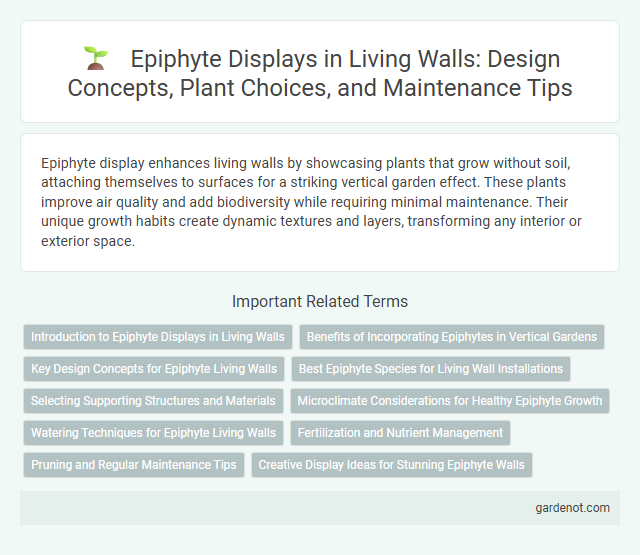Epiphyte display enhances living walls by showcasing plants that grow without soil, attaching themselves to surfaces for a striking vertical garden effect. These plants improve air quality and add biodiversity while requiring minimal maintenance. Their unique growth habits create dynamic textures and layers, transforming any interior or exterior space.
Introduction to Epiphyte Displays in Living Walls
Epiphyte displays in living walls utilize air plants that naturally grow without soil, attaching themselves to surfaces for unique vertical greenery. These plants enhance air quality and add diverse textures and forms to interior and exterior living wall installations. Incorporating epiphytes like Tillandsia species creates low-maintenance, visually dynamic living walls that thrive in urban environments.
Benefits of Incorporating Epiphytes in Vertical Gardens
Incorporating epiphytes in living walls enhances air purification by naturally filtering pollutants and increasing oxygen levels. Their minimal soil requirements reduce maintenance needs and prevent excess water damage often associated with traditional vertical gardens. Epiphytes also promote biodiversity by providing habitats for beneficial insects and microfauna, contributing to a healthier indoor ecosystem.
Key Design Concepts for Epiphyte Living Walls
Epiphyte living walls rely on key design concepts such as proper air circulation, lightweight support structures, and moisture retention techniques to mimic natural habitats. Selecting compatible plant species like orchids, bromeliads, and ferns enhances sustainability and visual appeal. Incorporating modular panels with efficient irrigation systems ensures optimal growth and maintenance for epiphyte displays.
Best Epiphyte Species for Living Wall Installations
Best epiphyte species for living wall installations include Tillandsia, commonly known as air plants, prized for their minimal soil needs and resilience in varied light conditions. Orchids, especially Phalaenopsis, thrive on vertical surfaces with their elegant blooms and adaptability to humidity levels typical of indoor environments. Bromeliads offer vibrant color and structural diversity, making them ideal for creating dynamic epiphyte displays that enhance both aesthetics and air quality in living walls.
Selecting Supporting Structures and Materials
Choosing the right supporting structures and materials for an epiphyte display ensures optimal plant health and longevity. Lightweight frames made from natural fibers or corrosion-resistant metals provide stable support while allowing air circulation essential for epiphytes. Materials such as cork bark, wire mesh, and reclaimed wood mimic natural habitats, promoting root attachment and moisture retention in living wall installations.
Microclimate Considerations for Healthy Epiphyte Growth
Epiphyte displays require careful microclimate management, balancing humidity levels between 60-80% to mimic natural rainforest conditions essential for healthy growth. Maintaining consistent air circulation without direct drafts prevents fungal infections while ensuring proper gas exchange. Temperature stability within 15-25degC supports metabolic functions, promoting vibrant foliage and robust root development in living wall epiphyte installations.
Watering Techniques for Epiphyte Living Walls
Epiphyte living walls require precise watering techniques to maintain optimal moisture without waterlogging the plants. Utilizing misting systems and drip irrigation ensures consistent hydration by replicating natural humidity levels suited for epiphytes such as Tillandsia and orchids. Monitoring humidity and air circulation is essential to prevent fungal growth and promote healthy epiphyte root respiration.
Fertilization and Nutrient Management
Epiphyte displays require precise fertilization techniques to support their unique nutrient absorption through air and rainwater rather than soil. Utilizing balanced, water-soluble fertilizers with micronutrients ensures optimal growth without overloading the delicate root structures. Implementing foliar feeding and controlled-release nutrient sources enhances nutrient management efficiency in living walls featuring epiphytes.
Pruning and Regular Maintenance Tips
Epiphyte displays thrive with precise pruning to remove dead or yellowing leaves, promoting healthy growth and airflow. Regular maintenance includes checking for pests and ensuring adequate humidity to mimic their natural habitat. Consistent cleaning and trimming prevent overcrowding, enhancing both the aesthetic appeal and vitality of the living wall.
Creative Display Ideas for Stunning Epiphyte Walls
Epiphyte displays transform living walls into dynamic, three-dimensional ecosystems by incorporating air plants, orchids, and bromeliads, which require minimal soil and thrive in vertical arrangements. Creative display ideas include using reclaimed wood panels with integrated mounting systems for easy plant attachment and drip irrigation, enhancing both aesthetics and sustainability. Layering diverse epiphyte species with varying textures and colors creates striking visual contrast that captures attention and promotes biodiversity.
Epiphyte display Infographic

 gardenot.com
gardenot.com